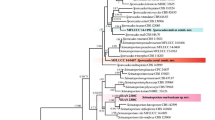Abstract
The ascomycete genus Diaporthe includes plant pathogens and endophytes on a wide range of hosts including economically important crops. Anamorphs are coelomycetous and reside in the genus Phomopsis. Phomopsis amygdali is the causal agent of twig canker and blight of almonds. In a recent survey of dieback of almonds in Portugal, the most frequent fungi detected were Diaporthe/Phomopsis species. Isolates from almond and other Prunus species were characterised and grouped according to their microsatellite-primed PCR (MSP-PCR) profiles and representatives of the different groups were selected for a phylogenetic study based on the ITS rDNA region (ITS1–5.8S–ITS2). Combining morphological, cultural, molecular and pathogenicity data, three species were distinguished. Phomopsis amygdali was shown to be the main pathogen on almond and is epitypified in the present work. Diaporthe neotheicola is reported for the first time on this host. A third species represented by a single isolate could not be unequivocally identified.



Similar content being viewed by others
References
Adaskaveg JE, Forster H, Connell JH (1999) First report of fruit rot and associated branch dieback of almond in California caused by a Phomopsis species tentatively identified as P. amygdali. Plant Dis 83:1073
Alves A, Correia A, Luque J, Phillips AJL (2004) Botryosphaeria corticola sp. nov. on Quercus species, with notes and description of Botryosphaeria stevensii and its anamorph Diplodia mutila. Mycologia 96:598–613
Canonaco A (1936) Il seccume dei rameti di mandorlo in relazione ad alcuni micromiceti. Riv Patol Veget 26:145–164
Curzi M (1927) De novis theae micromycetibus pathogenis. Atti Ist Bot Univ Pavia 3:59–72
Delacroix G (1905) Sur une maladie des amandiers en Provence. Bull Trimest Soc Mycol Fr 21:180–185
Dias MRS, Lucas MT, Lopes MC (1982) Fungi Lusitaniae XXIX. Agron Lusit 41:175–192
Farr DF, Castlebury LA, Pardo-Schultheiss R (1999) Phomopsis amygdali causes peach shoot blight of cultivated peach trees in the southeastern United States. Mycologia 91:1008–1015
Farr DF, Castlebury LA, Rossman A (2002) Morphological and molecular characterization of Phomopsis vaccinii and additional isolates of Phomopsis from blueberry and cranberry in the eastern United States. Mycologia 94:494–504
Garofalo F (1973) L’Albicocco “Tonda di Costigliole”, nuovo ospite di Fusicoccum amygdali Del. Informatore Fitopatologico 23:13–15
Hyde KD, Zhang Y (2008) Epitypification: should we epitypify? J Zhejiang Univ Sci B 9:842–846
Kanematsu S, Yokoyama Y, Kobayashi T (1999) Taxonomic reassessment of the causal fungus of peach Fusicoccum canker in Japan. Ann Phytopathol Soc Jpn 65:531–536
Kanematsu S, Minaka N, Kobayashi T, Kudo A, Ohtsu Y (2000) Molecular phylogenetic analysis on ribosomal DNA internal transcribed spacer regions and comparison of fertility in Phomopsis isolates from fruit trees. J Gen Plant Pathol 66:191–201
Meyer W, Mitchell TG, Freedman EZ, Vilgalys R (1993) Hybridization probes for conventional DNA fingerprinting used as single primers in the polymerase chain reaction to distinguish strains of Cryptococcus neoformans. J Clin Microbiol 31:2274–2280
Mostert L, Crous PW, Kang JC, Phillips AJL (2001) Species of Phomopsis and a Libertella sp. occurring on grapevines with specific reference to South Africa: morphological, cultural, molecular and pathological characterization. Mycologia 93:146–167
Nilsson RH, Kristiansson E, Ryberg M, Hallenberg N, Larsson K-H (2008) Intraspecific ITS variability in the kingdom fungi as expressed in the international sequence databases and its implications for molecular species identification. Evol Bioinformatics 4:193–201
Pantidou ME (1973) Fungus-host index for Greece. Benaki Phytopathol Inst, Kiphissia, Athens
Phillips AJL, Oudemans PV, Correia A, Alves A (2006) Characterization and epitypification of Botryosphaeria corticis, the cause of blueberry cane canker. Fungal Divers 21:141–155
Rehner SA, Uecker FA (1994) Nuclear ribosomal internal transcribed spacer phylogeny and host diversity in the coelomycete Phomopsis. Can J Bot 72:1666–1674
Santos JM, Phillips AJL (2009) Resolving the complex of Diaporthe (Phomopsis) species occurring on Foeniculum vulgare in Portugal. Fungal Divers 34:111–125
Santos JM, Correia VG, Phillips AJL (2010) Primers for mating-type diagnosis in Diaporthe and Phomopsis: their use in teleomorph induction in vitro and biological species definition. Fungal Biol 114:255–270
Trigui A (1968) Sur la présence en Tunisie de Fusicoccum amygdali Delacroix sur Amandier. Bull ENSAT 18/19:65–68
Tuset JJ, Portilla MT (1989) Taxonomic status of Fusicoccum amygdali and Phomopsis amygdalina. Can J Bot 67:1275–1280
Uddin W, Stevenson KL (1997) Pathogenicity of a species of Phomopsis causing a shoot blight on peach in Georgia and evaluation of possible infection courts. Plant Dis 81:983–989
Uecker FA (1988) A world list of Phomopsis names with notes on nomenclature, morphology and biology. Mycologia Memoir 13:1–231
van Niekerk LM, Groenewald JZ, Farr DF, Fourie PH, Hallen F, Crous PW (2005) Reassessment of Phomopsis species on grapevine. Australas Plant Pathol 34:27–39
van Rensburg JCJ, Lamprecht SC, Groenewald JZ, Castebury LA, Crous PW (2006) Characterization of Phomopsis spp. associated with die-back of rooibos (Aspalathus linearis) in South Africa. Stud Mycol 55:65–74
Acknowledgements
This work was financed by the European Regional Development Fund and Fundação para a Ciência e a Tecnologia (FCT) under the project PTDC/AGR-AAM/67064/2006 and J. Santos was supported by a research grant within the project. A. Phillips was supported by grant number SFRH/BCC/15810/2006 from FCT. João Inácio (Laboratório Nacional de Investigação Veterinária, Instituto Nacional de Recursos Biológicos, I.P.) helped with the construction of the MSP-PCR dendrogram, and Cecília Rego (Instituto Superior de Agronomia, Laboratório de Patologia Vegetal “Veríssimo de Almeida”) provided bibliographic material.
Author information
Authors and Affiliations
Corresponding author
Rights and permissions
About this article
Cite this article
Diogo, E.L.F., Santos, J.M. & Phillips, A.J.L. Phylogeny, morphology and pathogenicity of Diaporthe and Phomopsis species on almond in Portugal. Fungal Diversity 44, 107–115 (2010). https://doi.org/10.1007/s13225-010-0057-x
Received:
Accepted:
Published:
Issue Date:
DOI: https://doi.org/10.1007/s13225-010-0057-x




